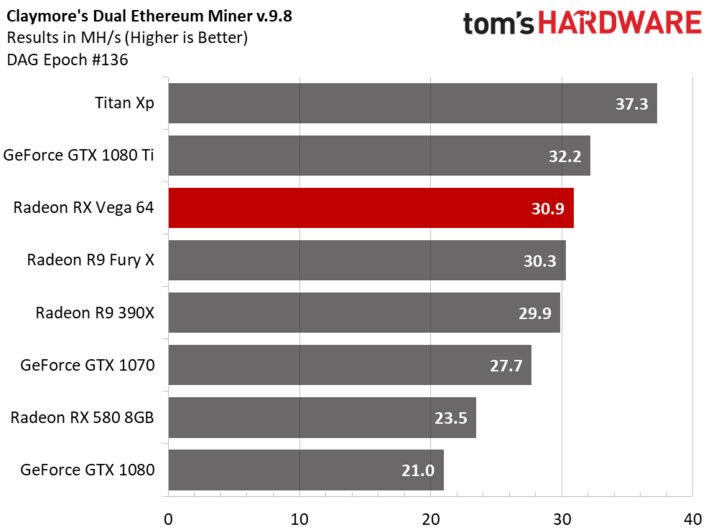Good question, short answer: Jain. The latest version of Claymore's Dual Ethereum AMD/Nvidia GPU Miner (v9.8) includes support for Radeon RX Vega, so we used it for our mining benchmark. All AMD cards run in so-called ASM mode, which requires final fine-tuning with the -dcri command-line option.
The tested Radeon R9 Fury X achieved its best hash rate with the default -dcri 85, while the Radeon R9 390X optimally shot at -dcri 20. After experimenting with fine tuning for the Sapphire Nitro+ RX 580 8GB, we ended up with even slightly higher hash rates using the -asm 2 switch for alternative ASM kernel mode.
With the Radeon RX Vega64, however, you couldn't do much wrong or better in the end. Deviating adjustments from the default -dcri 30 did nothing to influence performance again positively.

The most striking exception in our chart is the GeForce GTX 1080, which falls even further behind a GTX 1070. This is a known latency problem, because also the program code of our benchmark is optimized for GDDR5 and not for GDDRX5.
Both the 1080 Ti and Titan Xp elegantly bypass this bottleneck with their much wider 384-bit memory interface. If you could build your card from Nvidia's spare parts rack yourself, it would probably end up being a GP102 processor with a 384-bit bus with 9Gb/s GDDR5, which you can easily use on 10Gb/s. It would be nice, but unfortunately it doesn't work.
The good news for all gamers: AMD's Radeon RX Vega64 is apparently not (yet) the mining monster many might have hoped for. Well, at least not in the current state and with no further software optimized for Vega. However, if serious optimizations are still possible, this first statement is of course immediately relativized again.
We know that for professional mining, even the firmware is screwed around, that clock rates and latency are changed and thus in the end also much higher hash rates are possible than just so out-of-the-box. But neither AMD nor Nvidia wanted to comment on how high they see the hash performance themselves. And, of course, we must not forget that our values were created with reference cards in the factory state.
However, given the current price of Vega64, we suspect that miners will probably be more inclined towards a Radeon R9 390 or the RX 400/500 series and will continue to fish for maps in the bay. Even if this has already mutated into deep-sea fishing. The 500 euros for a black Vega64 seem more like a non-bargain. But who knows? Greed knows no bounds.
- 1 - Einführung und Übersicht
- 2 - Details zu Architektur und HBM2-Speicher
- 3 - Demontage, Kühler und Interposer-Details
- 4 - Platinendesign und Detailinformationen
- 5 - Ashes of the Singularity: Escalation
- 6 - Battlefield 1
- 7 - Warhammer 40,000: Dawn of War III
- 8 - Doom (2016)
- 9 - Tom Clancy's Ghost Recon Wildlands
- 10 - Hitman (2016)
- 11 - Metro Last Light (Redux)
- 12 - Rise of the Tomb Raider
- 13 - Tom Clancy's The Division
- 14 - The Witcher 3
- 15 - Und kann sie Mining?
- 16 - Leistungsaufnahme im Detail
- 17 - Takt, Temperaturen und Geräuschemission
- 18 - Zusammenfassung und Fazit
































Kommentieren